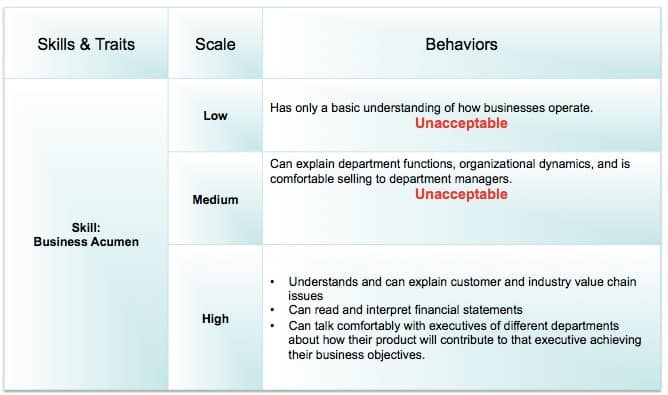If you haven’t built a team of highly qualified and skilled sales professionals, don’t waste your time and money investing in sales processes, training, compensation plans, technology, marketing support, or strong products and services.
Depending on the industry, somewhere between 20 and 33 percent of salespeople aren’t capable of being successful at their jobs. It’s a frightening statistic, but scarier still is understanding that a bad hire—a salesperson who lasts less than a year—can cost your company anywhere from $250K to $800K (or more), including lost business opportunity.
In today’s hyper-competitive buyers’ market, “mis-hiring” has become an epidemic, forcing sales leaders to rethink their approach to hiring. They have learned, all too painfully, that yesterday’s hiring methods no longer apply. These lessons include:
- A salesperson with a past record of stellar performance won’t automatically perform in the future.
- Accuracy in salespeople’s resumes has declined, so rigorous reference checking is required.
- A candidate who interviews well enough to get the job may not be good enough to deliver the numbers after they are hired.
To change the mis-hiring paradigm, many sales leaders are casting aside their informal, gut-instinct approach and building high-performance sales teams by implementing a formal hiring process.
A formal process provides an objective assessment of each candidate, which is one of the most critical success factors in hiring.
Key elements of an effective sales hiring process include:
1. Forming an internal hiring team comprised of multiple stakeholders. For a small company, those stakeholders might include the CEO, VP of sales, and VP of marketing. A larger company might enlist the regional VP of sales, HR representative, and local sales manager.
2. Stakeholder agreement on how the position and company will be described to the candidate. Hiring is a balance between buying (candidates selling themselves) and selling (convincing the candidate to join your team). Highly qualified candidates are more likely to join your team if everyone they meet articulates a consistent story.
3. Establishing a benchmark against which the process will be measured. Data points might include the average salesperson’s performance against quota, their average tenure, the time to first sale, etc.
4. Building a profile for each unique sales position that defines the critical skills and traits required for success. Each skill and trait should be prioritized and scaled to measure the degree of candidate compliance. The profile for a sales “hunter,” for example, is quite different than the profile for a “farmer.” In the example below, stakeholders have determined that a reasonably high level of business knowledge is required for this particular position. A full profile usually contains 12-20 skills and 6-12 traits.
5. Writing an accurate job description. Don’t include profile details in the job description because a candidate could potentially identify what the interviewer is looking for and prepare “perfect” answers.
6. Providing recruiters and HR staff with a simple document that filters out “fatally flawed” candidates. For example, if a candidate must have at least five years of sales success in your industry, anyone who does not meet that criterion is eliminated. Screening against specific criteria allows internal hiring team members to dedicate their time to more qualified candidates. Technology solutions that perform much of this screening are readily available.
7. Engineering a set of first-round interview questions. Used as directed, these questions will enable internal team members to probe for required skills and traits based on the profile. Interviewer observations as well as the candidate’s answers are recorded and analyzed later.
8. Training the hiring team on how to perform structured interviews. It is essential that interviewers follow the questions, which have been specifically designed to generate responses that reveal whether the candidate possesses the traits and skills required for job success.
9. Educating interviewers about the importance of objectivity. Structured interviewing reduces the natural tendency to view a candidate subjectively, which could lead to overlooking weaknesses.
10. Devising a set of second round interview questions to facilitate further exploration for critical skills and traits, and to enable the interviewer to identify and quantify weaknesses uncovered in the previous interview.
11. Validating the candidate’s claims and uncovering inconsistencies through a rigorous reference checking procedure. Effective reference checking requires persistence and skill, because many companies are reluctant to provide information about former employees. The best reference checks are conducted with people not provided by the candidate. Sales leaders with a wide network can often find “blind” references who will offer an honest appraisal of a candidate, if they are confident that the discussion remains between them and the person doing the hiring.
12. Requiring sales position candidates to substantiate assertions about their past performance with tax or other formal documentation. If they claim they made $500k a year for the past five years, they should be able to prove it.
13. Requiring final candidates to participate in sales call and presentation simulations. Evaluate the candidates against required skills and personality traits derived from the profile.
14. Implementing psychometric testing and background checking. These tests rarely lead to hiring someone you have no enthusiasm for and often “expose” candidates who have managed to hide deficiencies through the interview process.
15. Engineering individual ramp-up or on-boarding plans to ensure that the gaps between the profile and the candidate’s proven skill set are closed during the first thirty to ninety days of employment.
16. Implementing a continuous improvement component. In order for this process to continue working into the future, there must be a mechanism that provides stakeholders with feedback and includes the flexibility to make adjustments.
You may initially think that this kind of formal process will “take too much time,” but you’ll quickly discover that the number of candidates who make it to the final stages is limited. The process works like a sales funnel; candidates “qualify out” all along the way. As a result, the hiring team has time to focus only on the most qualified candidates. Additionally, candidates get impression that your company is serious and well-managed. Finally, both candidate and company become aware of the gaps between the candidate’s capabilities and what’s required to get the job done, as well as how those gaps will be filled.
Dave Stein is an internationally-recognized expert in B2B sales performance. Read his blog at davestein.biz and follow him on Twitter: @davestei
Image courtesy of Tim Caynes.
relpost-thumb-wrapper
close relpost-thumb-wrapper
Latest posts by Eliot Burdett (see all)
- 31 Must-Know Sales Follow-Up Statistics for 2024 Success – December 21, 2023
- 7 Success Characteristics That Define Top Performers – December 19, 2023
- 5 Reasons Your Top Employees Quit (Stop Doing This to Stop Them Leaving) – December 14, 2023






